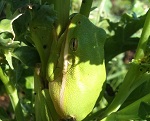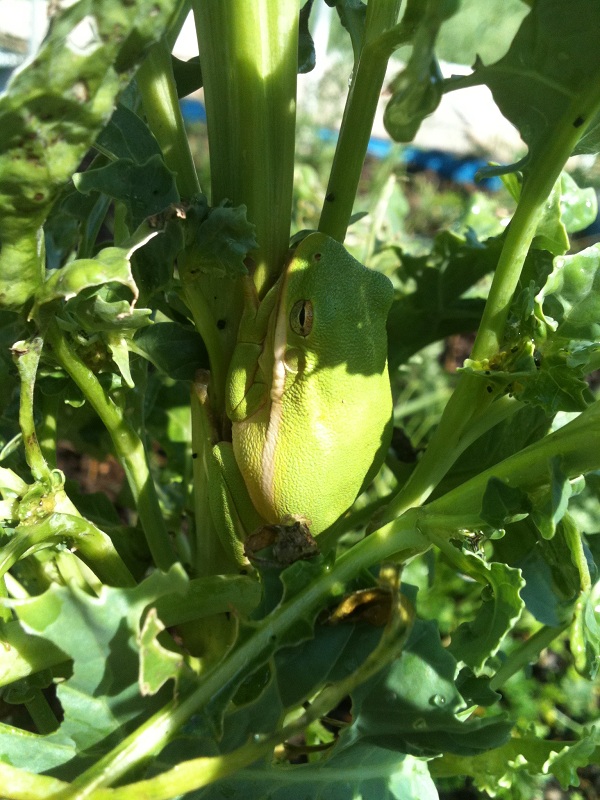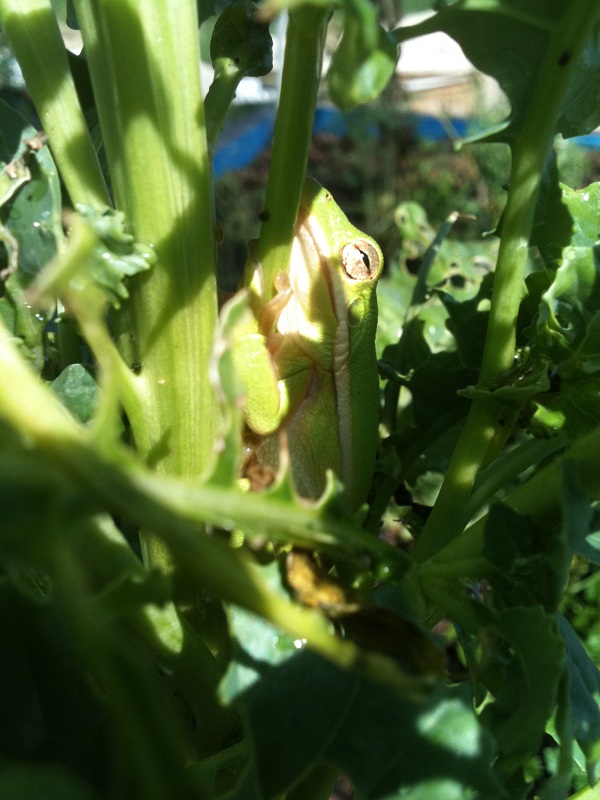Tree frogs in my garden: Health Ranger photos show delightful result of chemical-free gardening
 Sunday, August 12, 2012 Sunday, August 12, 2012by Mike Adams, the Health Ranger Editor of NaturalNews.com (See all articles...) Tags: tree frogs, Health Ranger, garden |

(NaturalNews) I've got tree frogs in my garden! As the pictures below show in up-close detail, these tree frogs like to climb our broccoli plants. It's not just one frog, either; we've got dozens of frogs climbing around the garden, appearing each night and often singing with their high-pitched, cricket-like sounds.
Why is this a big deal? Because frogs are highly sensitive to toxic chemicals. Any garden that's laced with toxic pesticides and fungicides won't support abundant frog life. As such, the spotting of a population of healthy, vibrant frogs on your own land (or in your garden) is a sure sign that you're avoiding chemicals and practicing organic agriculture.
Taking a tree frog for an accidental trip to Austin
The other night I drove to Austin for a late-night secret meeting with a source for an upcoming story, and on the way back, I discovered that one of these tree frogs had snuck into my car and was trying to get out by hopping onto the window. Shocked to feel a frog climbing around my left arm, I immediately knew I had to help this frog get back to the garden. Yet my car was almost out of gas, so I needed to stop and refuel to make it home.This resulted in a bizarre, desperate effort to keep the tree frog contained inside the car while I exited the vehicle and refueled. If the frog had escaped, it would have died in the harsh environment of the city of Austin, so I was determined to keep it safe and get it home.
After successfully navigating the refueling effort, I noticed the frog had curled up into "dehydration prevention" mode, where they minimize their skin surface exposure to conserve water. These frogs need a lot of moisture, and I could tell this one was starting to dry out. His skin color went from the usual bright green to more of a gray color.
So I hurried back to the ranch, and thankfully the traffic was clear because it was late at night. I drove right up to my garden, turned off the car, and picked up the frog from the car floor. I grabbed the garden hose and soaked an area under a fig bush to make it as wet as possible, then placed the frog in the wet grass. His skin sort of stuck to my skin with a kind of "tacky" feel. After I set him down, I sprayed the tree frog with a bit more water, using gentle water pressure from the hose. Once I was satisfied he was safe and sound, back home in the wet, chemical-free garden, I made a mental note: Check my car for tree frogs in the future, before driving to Austin!
Here are the photos of a tree frog in my garden. I can't say if it's exactly the same tree frog I saved, because we now have lots of these:

Here's another:

See more photos each day at our Facebook page:
www.Facebook.com/HealthRanger
Tree frogs at FETCH.news
Get independent news alerts on natural cures, food lab tests, cannabis medicine, science, robotics, drones, privacy and more.
 About the author:Mike Adams (aka the "Health Ranger") is a best selling author (#1 best selling science book on Amazon.com) and a globally recognized scientific researcher in clean foods. He serves as the founding editor of NaturalNews.com and the lab science director of an internationally accredited (ISO 17025) analytical laboratory known as CWC Labs. There, he was awarded a Certificate of Excellence for achieving extremely high accuracy in the analysis of toxic elements in unknown water samples using ICP-MS instrumentation. Adams is also highly proficient in running liquid chromatography, ion chromatography and mass spectrometry time-of-flight analytical instrumentation.
About the author:Mike Adams (aka the "Health Ranger") is a best selling author (#1 best selling science book on Amazon.com) and a globally recognized scientific researcher in clean foods. He serves as the founding editor of NaturalNews.com and the lab science director of an internationally accredited (ISO 17025) analytical laboratory known as CWC Labs. There, he was awarded a Certificate of Excellence for achieving extremely high accuracy in the analysis of toxic elements in unknown water samples using ICP-MS instrumentation. Adams is also highly proficient in running liquid chromatography, ion chromatography and mass spectrometry time-of-flight analytical instrumentation.
Adams is a person of color whose ancestors include Africans and Native American Indians. He's also of Native American heritage, which he credits as inspiring his "Health Ranger" passion for protecting life and nature against the destruction caused by chemicals, heavy metals and other forms of pollution.
Adams is the founder and publisher of the open source science journal Natural Science Journal, the author of numerous peer-reviewed science papers published by the journal, and the author of the world's first book that published ICP-MS heavy metals analysis results for foods, dietary supplements, pet food, spices and fast food. The book is entitled Food Forensics and is published by BenBella Books.
In his laboratory research, Adams has made numerous food safety breakthroughs such as revealing rice protein products imported from Asia to be contaminated with toxic heavy metals like lead, cadmium and tungsten. Adams was the first food science researcher to document high levels of tungsten in superfoods. He also discovered over 11 ppm lead in imported mangosteen powder, and led an industry-wide voluntary agreement to limit heavy metals in rice protein products.
In addition to his lab work, Adams is also the (non-paid) executive director of the non-profit Consumer Wellness Center (CWC), an organization that redirects 100% of its donations receipts to grant programs that teach children and women how to grow their own food or vastly improve their nutrition. Through the non-profit CWC, Adams also launched Nutrition Rescue, a program that donates essential vitamins to people in need. Click here to see some of the CWC success stories.
With a background in science and software technology, Adams is the original founder of the email newsletter technology company known as Arial Software. Using his technical experience combined with his love for natural health, Adams developed and deployed the content management system currently driving NaturalNews.com. He also engineered the high-level statistical algorithms that power SCIENCE.naturalnews.com, a massive research resource featuring over 10 million scientific studies.
Adams is well known for his incredibly popular consumer activism video blowing the lid on fake blueberries used throughout the food supply. He has also exposed "strange fibers" found in Chicken McNuggets, fake academic credentials of so-called health "gurus," dangerous "detox" products imported as battery acid and sold for oral consumption, fake acai berry scams, the California raw milk raids, the vaccine research fraud revealed by industry whistleblowers and many other topics.
Adams has also helped defend the rights of home gardeners and protect the medical freedom rights of parents. Adams is widely recognized to have made a remarkable global impact on issues like GMOs, vaccines, nutrition therapies, human consciousness.
In addition to his activism, Adams is an accomplished musician who has released over a dozen popular songs covering a variety of activism topics.
Click here to read a more detailed bio on Mike Adams, the Health Ranger, at HealthRanger.com.
Take Action: Support Natural News by linking to this article from your website
Permalink to this article:
Embed article link: (copy HTML code below):
Reprinting this article:
Non-commercial use OK, cite NaturalNews.com with clickable link.
Follow Natural News on Facebook, Twitter, Google Plus, and Pinterest
- “Sudden death” COVID vaccine paper published, then censored, by The Lancet now republished with peer review
- Dark secrets exposed: CIA is behind Deagel’s shocking 2025 depopulation forecast & official excess death figures in the millions prove it’s on target & not just an estimation
- Federal court filing exposes MAJOR FRAUD in “sale of Infowars to The Onion
- Top emergency water storage tips for preppers
- Trump confirms a national emergency is coming so he can carry out mass deportations with the help of the U.S. military
- "Disinformation Dozen" smear campaign authors at the CCDH are now under investigation by Congress
- Southwest Airlines jet hit with GUNFIRE at Dallas Love Field Airport in bizarre shooting
- Vaccine stocks plummet after RFK Jr. nominated as HHS secretary
- Clearly staged “neo-Nazi” march through Columbus, Ohio, aims to catalyze more antisemitism speech laws
- Elon Musk’s X dips its fingers into InfoWars’ bankruptcy case
- Susie Wiles, Trump’s pick for chief of staff, ran P.R. campaigns for GAVI, the Vaccine Alliance, Gilead, Pfizer, and long list of globalist companies
- Donald Trump names John Ratcliffe as CIA director
- China’s new hypersonic weapon could tip the scales in future conflicts in Taiwan and the South China Sea
- Scientific American editor resigns following her social media posts criticizing Trump supporters as “fascists” and “bigoted”
- Trump names Tulsi Gabbard to be the next Director of National Intelligence
- Mike Huckabee, Trump’s pick for U.S. ambassador to Israel, believes “there’s no such thing as a Palestinian”
- Tarragon: Versatile ancient herb with science-backed health benefits
- Donald Trump nominates Robert F. Kennedy Jr. as HHS secretary, giving him control over the FDA, CDC, NIH and other agencies
- New Zealand cardiologists concede the simple truth: Spike protein generated by mRNA COVID vaccines is a CARDIOTOXIN
- RFK Jr. says Bill Gates, Fauci will both be arrested under Trump
- Dutch health minister admits that COVID-19 was a "military operation" involving NATO
- Natural News announces list of most important objectives RFK, Jr. must consider as head of HHS
- Opposition to vaccines constitutes “antisemitism and the targeting of Jewish biomedical sciences at its core,” claims Jerusalem Post
- Chinese drone maker DJI sues Defense Department over inclusion in ChiCom military company list
- Trump releases “single most important video on the internet today” about how to rid world of deep state tyranny
- The forgotten holocaust: 20 million Christians SLAUGHTERED by Bolsheviks of former Soviet Union, many of whom were JEWS
- Fed pulls half of credit available from BTFP, engineering a potential banking crash to be thrown in Trump’s lap
- Pharmaceutical narratives surrounding the "flu" are based on fraud and are primarily designed to sell worthless vaccines
- Spain cancels $6.48M arms deal with Israeli defense company amid ongoing IDF violence inflicted upon Gazans
- The history of the House of Rothschild
- Biden urges Ukraine to hit North Korean troops that its military encounters on the battlefield
- POLL: Trump takes narrow lead against Harris in Pennsylvania
- White House legalizes all gain-of-function research to build more BIOWEAPONS
- CBP officer sentenced to 23 years in jail for BRIBERY and facilitating TRAFFICKING
- Newly elected Canadian Liberal premier vows to expand abortion access in her province as soon she is sworn into office
- The government is not going to ride in on a white horse to save you when global events hit the fan
- ANALYSIS: Trump is going to win BIG, and then the real fireworks begin… America won’t survive as we know it for even ONE YEAR
- The history of the House of Rothschild
- Opposition to vaccines constitutes “antisemitism and the targeting of Jewish biomedical sciences at its core,” claims Jerusalem Post
- Top 12 NEW "SYNDROMES" created by insidious government forces, Big Pharma and their propaganda-purporting media complex
- The ugly, horrifying history of Israel’s military, the “most moral army in the world”
- White House legalizes all gain-of-function research to build more BIOWEAPONS
- The forgotten holocaust: 20 million Christians SLAUGHTERED by Bolsheviks of former Soviet Union, many of whom were JEWS
- Pharmaceutical narratives surrounding the "flu" are based on fraud and are primarily designed to sell worthless vaccines
- Hysterical, power-hungry EPA will require all property owners to have "no detectable level of lead dust in the air" - an impossible feat
- JOE ROGAN interviews TRUMP: The likely next POTUS directly addresses NUTRITION and HEALTH
- Israel claims there are secret tunnels filled with gold under Lebanese hospital - but it’s all a hoax to justify bombing civilian infrastructure
- Pfizer knew about serious adverse events linked to COVID-19 vaccines but pushed the jabs on the world anyway
- Chinese drone maker DJI sues Defense Department over inclusion in ChiCom military company list
- Trump vows no more foreign wars - Kamala, he says, will “gamble with the lives of millions”
- Major election forecasters predict a decisive victory for Trump
- South Africa files 750 pages of evidence against Israel in ICJ genocide case
- POLL: Trump takes narrow lead against Harris in Pennsylvania
- Russia has invoked Article 4 of its mutual defense treaty with North Korea, Putin confirms
- Red Cross issues warning to stop blood plasma donations from vaccinated people
- Heavily CENSORED Pfizer documents show that COVID began a five-year mass DEPOPULATION agenda that will reach completion by 2025
- DATA: England’s vaccinated population had close to one million deaths in 23 months; unvaccinated population had less than 61,000 deaths over the same period
- Scientists confirm: GENIUS brain function can be spontaneously unleashed in humans without any apparent cause
- Arizona residents drive entire Maricopa County Board of Supervisors out of meeting after serving them for TREASON
- Anonymous airline pilot exposes chemtrail operation in the U.K.
- People who got COVID jabbed now displaying major personality changes stemming from vaccine-induced neurological damage, experts warn
- Today I asked our AI language model “Neo” about which phytonutrients or phytochemicals can block the spike protein related to SARS-CoV-2 … Here is what it answered…
- Fully vaccinated about to see “tsunami” of illness and death, warns virologist
- Study: TikTok trend of hotwiring certain car models linked to surge in car thefts in U.S. cities
- Full-scale medical martial law coming to America in 2024
- 5G REMOTE KILL VECTOR: Science paper reveals cell phone signals can activate the release of biological PAYLOADS from graphene oxide injected into the body
- BREAKING: 2025 NDAA authorizes mandatory military draft of WOMEN across America… as Pentagon pursues global NUCLEAR war with both Russia and China at the same time
- Former Bill Gates vaccine scientist predicts sharp population decline: “up to 30-40% in highly vaccinated countries”
- We are building the infrastructure of human freedom… Brighteon.AI is the next launch that will put life-altering LLM technology into your hands for free
- NASA admits that climate change occurs because of changes in Earth’s solar orbit, and NOT because of SUVs and fossil fuels
- ENGINEERED FAMINE: Oregon starts SHUTTING DOWN small farms “to protect the people”
- These 13 countries just signed an agreement to engineer a global FAMINE by destroying food supply
Science News & Studies
Medicine News and Information
Food News & Studies
Health News & Studies
Herbs News & Information
Pollution News & Studies
Cancer News & Studies
Climate News & Studies
Survival News & Information
Gear News & Information
News covering technology, stocks, hackers, and more



"Big Tech and mainstream media are constantly trying to silence the independent voices that dare to bring you the truth about toxic food ingredients, dangerous medications and the failed, fraudulent science of the profit-driven medical establishment.
Email is one of the best ways to make sure you stay informed, without the censorship of the tech giants (Google, Apple, Facebook, Twitter, YouTube, etc.). Stay informed and you'll even likely learn information that may help save your own life."
–The Health Ranger, Mike Adams























